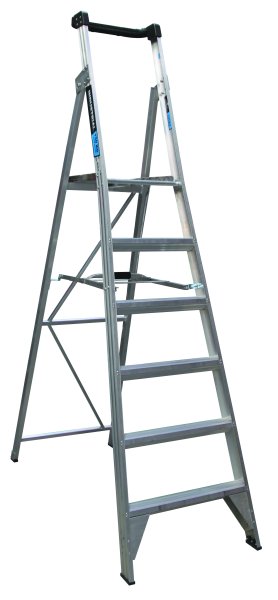When choosing a ladder, safety and functionality should be top priorities. Whether for home improvement, trade work, or industrial applications, choosing the right ladder ensures efficiency while minimising risks. Key factors such as ladder type, height, weight capacity, material, and compliance with New Zealand safety standards play a crucial role in making an informed decision. Additionally, proper usage, regular maintenance, and adherence to best practices help prevent accidents and extend the ladder’s lifespan. This article explores the essential considerations when buying a ladder, safety regulations in New Zealand, and practical tips for safe ladder use.
What are the key considerations when buying a ladder?
When buying a ladder, we recommend you consider the following key factors:
- Determine the intended use - whether you need the ladder for home, trade, or industrial use. Consider the tasks you'll be performing, such as electrical work at height, painting, pruning, or accessing rooftops.
- Identify the ladder type that is suitable for you. Step ladders are ideal for indoor or low-height tasks. Extension ladders are suitable for reaching higher places. Platform ladders provide extra stability with a standing platform. Multi-purpose ladders are versatile and adjustable for various applications.
- Ensure the ladder is tall enough to reach your workspace safely. Consider working height, which includes your own height when standing on the ladder.
- Ladders sold in New Zealand have weight classifications (load ratings). Domestic ladders, suitable for home use, have a weight rating of up to 100kg. Trade/Industrial ladders, designed for work environments, have a weight rating of 120-150kg. Choose a ladder that can support your weight along with tools or materials.
- Ladders are manufactured from varied materials. Aluminium ladders are lightweight, durable, and resistant to rust. Fibreglass ladders are non-conductive and safer for electrical work. Wooden ladders, although less common but sturdy, are mainly used in specialty applications.
- Ensure the ladder complies with New Zealand safety standards and regulations. We recommend you look for certified products that meet WorkSafe NZ guidelines.
- Consider various stability and safety features like non-slip feet and rungs for a better grip; locking mechanisms for secure positioning; and handrails or safety rails for added support.
- Consider foldable or telescopic designs for easy storage and transport.
What are the New Zealand ladder standards and regulations?
In New Zealand, ladder safety is governed by specific standards and regulations to ensure safe use in both residential and commercial settings. These standards outline the design, construction, and usage requirements to minimize risks and enhance workplace safety. The key New Zealand ladder standards include:
- AS/NZS 1892 – Covers portable ladders, specifying requirements for materials, design, construction, and testing.
- AS 1657 – Provides guidelines for fixed platforms, walkways, stairways, and ladders to ensure safe access and working conditions.
- ISO 14122-4 – Specifies safety requirements for fixed ladders, focusing on ergonomic and structural considerations.
WorkSafe New Zealand also provides guidance on ladder use, emphasizing proper selection, setup, and maintenance to reduce workplace accidents. Contractors and businesses must ensure compliance with these standards to meet regulatory obligations and maintain a safe working environment.
What are the best practices when using ladders?
Ensuring safety while using ladders involves adhering to several key practices:
- Choose an appropriate ladder that suits the specific task. Options include single pole ladders (up to 9 meters), extension ladders (up to 15 meters), step ladders (up to 6.1 meters), dual-purpose ladders, and platform (podium) ladders.
- Before each use, inspect the ladder for damage or defects such as cracks, missing pieces, bent stiles or rungs, or worn rubber feet.
- Set the ladder on a solid, level base. For stability, position straight ladders at a 1:4 ratio—1 meter out at the base for every 4 meters of height.
- Ensure the treads are horizontal and the ladder extends at least 1 meter above the landing point.
- Always face the ladder when ascending or descending, maintaining three points of contact. Avoid carrying tools in your hands - instead, use a tool belt.
- Keep your body centered between the ladder rails to maintain balance. If an area is out of reach, descend and reposition the ladder.
- Ensure the combined weight of the user and any tools does not exceed the ladder's weight-rated capacity.
Why is it important to service and maintain ladders?
Regular maintenance is crucial to ensure ladder safety and longevity:
- Conduct routine inspections and checks for visible defects, including loose rivets, splits in stiles, and functioning locking mechanisms.
- Keep ladders clean and free from contaminants like oil, grease, or chemicals that could cause slips or degrade the material.
- Store ladders in a dry, secure area to prevent exposure to elements that could cause deterioration.
- Immediately address any identified issues. Repairs should restore the ladder to its original design specifications and be performed by qualified experts.
By prioritising ladder maintenance, businesses and individuals can comply with New Zealand safety standards, extend the ladder’s lifespan, and create a safer working environment. Active Electrical Suppliers Ltd offers a range of options, sources from trusted suppliers. Our inventory includes various ladder types suitable for different applications, ensuring both safety and functionality. With branches nationwide, contractors can conveniently access quality ladders and related equipment.
To view our range of height and access equipment, click here or visit your local Active Electrical Suppliers Ltd branch.
by Sean Aucamp, 01 May 2025
References:
6 osha.gov




